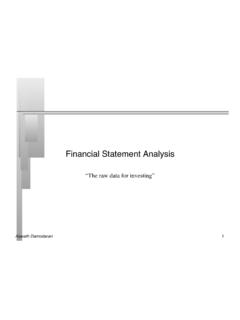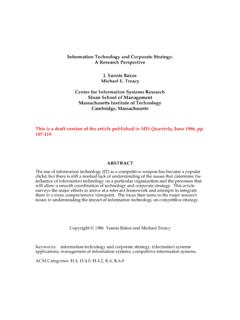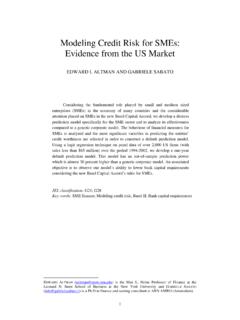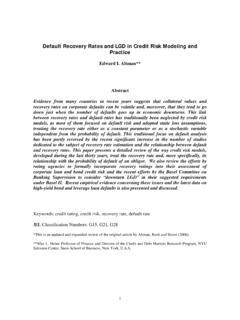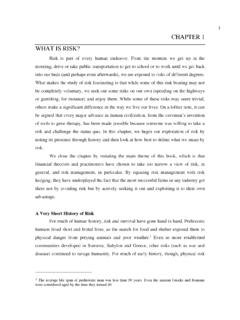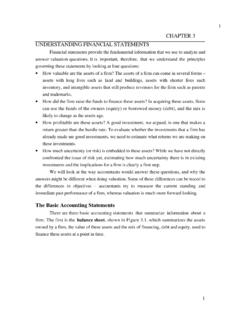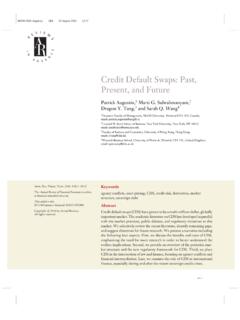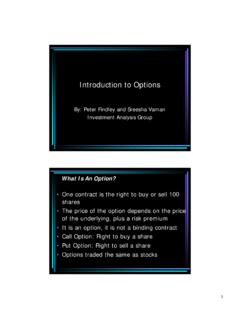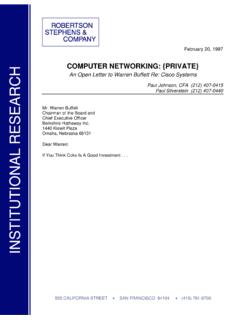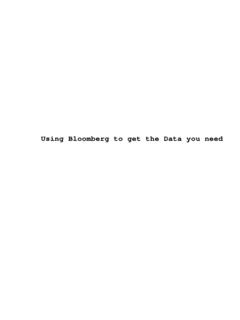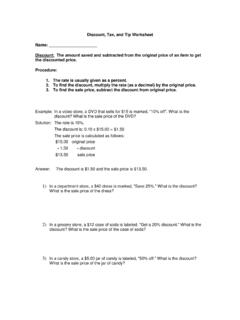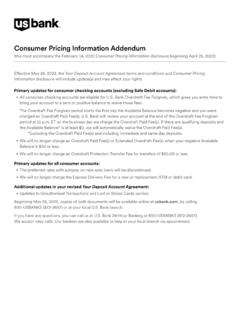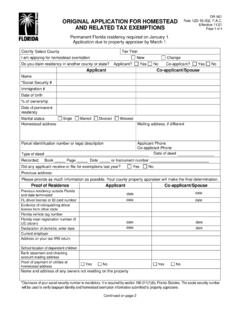Transcription of The Cost of Illiquidity - New York University
1 Aswath Damodaran1 The Cost of IlliquidityAswath DamodaranAswath Damodaran2 What is Illiquidity ? The simplest way to think about Illiquidity is to consider it the cost of buyer sremorse: it is the cost of reversing an asset trade almost instantaneously afteryou make the trade. Defined thus, all assets are illiquid. The difference is really a continuum, withsome assets being more liquid than others. The notion that publicly traded firms are liquid and private businesses are notis too , widely held stock in developed marketStock in traded company with small floatStock in lightly traded, OTC or emerging market stockTreasury bonds and billsHiihgly rated corporate bondsReal assetsPrivate business with controlPrivate business without controlWhich is more illiquid?
2 Most liquidLeast liquidAswath Damodaran3 The Components of Trading Costs for an asset Brokerage Cost: This is the most explicit of the costs that any investor paysbut it is by far the smallest component. Bid-Ask Spread: The spread between the price at which you can buy an asset(the dealer s ask price) and the price at which you can sell the same asset atthe same point in time (the dealer s bid price). Price Impact: The price impact that an investor can create by trading on anasset, pushing the price up when buying the asset and pushing it down whileselling.
3 Opportunity Cost: There is the opportunity cost associated with waiting totrade. While being a patient trader may reduce the previous two components oftrading cost, the waiting can cost profits both on trades that are made and interms of trades that would have been profitable if made instantaneously butwhich became unprofitable as a result of the Damodaran4 Why is there a bid-ask spread? In most markets, there is a dealer or market maker who sets the bid-ask spread,and there are three types of costs that the dealer faces that the spread isdesigned to cover. The first is the risk cost of holding inventory; the second is the cost of processing orders and the final cost is the cost of trading with more informed investors.
4 The spread has to be large enough to cover these costs and yield a reasonableprofit to the market maker on his or her investment in the Damodaran5 The Magnitude of the SpreadAswath Damodaran6 More Evidence of Bid-Ask Spreads The spreads in government securities are much lower than the spreads ontraded stocks in the United States. For instance, the typical bid-ask spread on aTreasury bill is less than of the price. The spreads on corporate bonds tend to be larger than the spreads ongovernment bonds, with safer (higher rated) and more liquid corporate bondshaving lower spreads than riskier (lower rated) and less liquid corporatebonds.
5 The spreads in equity markets are generally much higher than thespreads on markets, reflecting the lower liquidity in those markets and thesmaller market capitalization of the traded firms. While the spreads in the traded commodity markets are similar to those in thefinancial asset markets, the spreads in other real asset markets (real estate, ) tend to be much Damodaran7 The Determinants of the Bid-Ask Spread Studies by Tinic and West (1972), Stoll (1978) and Jegadeesh andSubrahmanyam (1993) find that spreads as a percentage of the price arecorrelated negatively with the price level, volume and the number of marketmakers, and positively with volatility.
6 Each of these findings is consistent withthe theory on the bid-ask spread. A study by Kothare and Laux, that looked at average spreads on the NASDAQ also looked at differences in bid-ask spreads across stocks on the addition to noting similar correlations between the bid-ask spreads, pricelevel and trading volume, they uncovered an interesting new variable. Theyfound that stocks where institutional activity increased significantly had thebiggest increase in bid-ask spreads. It might also reflect the perception on thepart of market makers that institutional investors tend to be informed investorswith more or better Damodaran8 Why is there a price impact?
7 The first is that markets are not completely liquid. A large trade can create animbalance between buy and sell orders, and the only way in which thisimbalance can be resolved is with a price change. This price change, thatarises from lack of liquidity, will generally be temporary and will be reversedas liquidity returns to the market. The second reason for the price impact is informational. A large trade attractsthe attention of other investors in that asset market because if might bemotivated by new information that the trader possesses. This price effect willgenerally not be temporary, especially when we look at a large number ofstocks where such large trades are made.
8 While investors are likely to bewrong a fair proportion of the time on the informational value of large blocktrades, there is reason to believe that they will be right almost as Damodaran9 How large is the price impact? Evidence from Studies ofBlock TradesAswath Damodaran10 Limitations of the Block Trade Studies These and similar studies suffer from a sampling bias - they tend to look atlarge block trades in liquid stocks on the exchange floor they also sufferfrom another selection bias, insofar as they look only at actual executions. The true cost of market impact arises from those trades that would have beendone in the absence of a market impact but were not because of the perceptionthat it would be Damodaran11 Round-Trip Costs (including Price Impact) as a Function ofMarket Cap and Trade SizeDollar Value of Block ($ thoustands) Damodaran12 Determinants of Price Impact Looking at the evidence, the variables that determine that price impact oftrading seem to be the same variables that drive the bid-ask spread.
9 Thatshould not be surprising. The price impact and the bid-ask spread are both afunction of the liquidity of the market. The inventory costs and adverseselection problems are likely to be largest for stocks where small trades canmove the market significantly. In many real asset markets, the difference between the price at which one canbuy the asset and the price at which one can sell, at the same point in time, isa reflection of both the bid-ask spread and the expected price impact of thetrade on the asset. Not surprisingly, this difference can be very large inmarkets where trading is infrequent; in the collectibles market, this cost canamount to more than 20% of the value of the Damodaran13 The Theory on Illiquidity Discounts Illiquidity discount on value: You should reduce the value of an asset by the expectedcost of trading that asset over its lifetime.
10 The Illiquidity discount should be greater for assets with higher trading costs The Illiquidity discount should be decrease as the time horizon of the investor holding the assetincreases Illiquid assets should be valued using higher discount rates Risk-Return model: Some Illiquidity risk is systematic. In other words, the Illiquidity increaseswhen the market is down. This risk should be built into the discount rate. Empirical: Assets that are less liquid have historically earned higher returns. Relating returns tomeasures of Illiquidity (turnover rates, spreads etc.)
